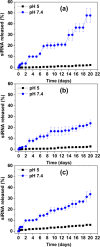Poly(amidoamine) dendrimer nanocarriers and their aerosol formulations for siRNA delivery to the lung epithelium
- PMID: 24811243
- PMCID: PMC4051247
- DOI: 10.1021/mp4006358
Poly(amidoamine) dendrimer nanocarriers and their aerosol formulations for siRNA delivery to the lung epithelium
Abstract
Small interfering RNA (siRNA)-based therapies have great promise in the treatment of a number of prevalent pulmonary disorders including lung cancer, asthma and cystic fibrosis. However, progress in this area has been hindered due to the lack of carriers that can efficiently deliver siRNA to lung epithelial cells, and also due to challenges in developing oral inhalation (OI) formulations for the regional administration of siRNA and their carriers to the lungs. In this work we report the ability of generation four, amine-terminated poly(amidoamine) (PAMAM) dendrimer (G4NH2)-siRNA complexes (dendriplexes) to silence the enhanced green fluorescent protein (eGFP) gene on A549 lung alveolar epithelial cells stably expressing eGFP. We also report the formulation of the dendriplexes and their aerosol characteristics in propellant-based portable OI devices. The size and gene silencing ability of the dendriplexes was seen not to be a strong function of the N/P ratio. Silencing efficiencies of up to 40% are reported. Stable dispersions of the dendriplexes encapsulated in mannitol and also in a biodegradable and water-soluble co-oligomer were prepared in hydrofluoroalkane (HFA)-based pressurized metered-dose inhalers (pMDIs). Their aerosol characteristics were very favorable, and conducive to deep lung deposition, with respirable fractions of up to 77%. Importantly, siRNA formulated as dendriplexes in pMDIs was shown to keep its integrity after the particle preparation processes, and also after long-term exposures to HFA. The relevance of this study stems from the fact that this is the first work to report the formulation of inhalable siRNA with aerosol properties suitable to deep lung deposition using pMDIs devices that are the least expensive and most widely used portable inhalers. This study is relevant because, also for the first time, it shows that siRNA-G4NH2 dendriplexes can efficiently target lung alveolar epithelial A549 cells and silence genes even after siRNA has been exposed to the propellant environment.
Figures









Similar articles
-
TPP-dendrimer nanocarriers for siRNA delivery to the pulmonary epithelium and their dry powder and metered-dose inhaler formulations.Int J Pharm. 2017 Jul 15;527(1-2):171-183. doi: 10.1016/j.ijpharm.2017.05.046. Epub 2017 May 23. Int J Pharm. 2017. PMID: 28549971
-
The interaction of dendrimer-doxorubicin conjugates with a model pulmonary epithelium and their cosolvent-free, pseudo-solution formulations in pressurized metered-dose inhalers.Eur J Pharm Sci. 2017 Nov 15;109:86-95. doi: 10.1016/j.ejps.2017.07.030. Epub 2017 Jul 31. Eur J Pharm Sci. 2017. PMID: 28774811
-
Effect of the Route of Administration and PEGylation of Poly(amidoamine) Dendrimers on Their Systemic and Lung Cellular Biodistribution.Mol Pharm. 2016 Jun 6;13(6):1866-78. doi: 10.1021/acs.molpharmaceut.6b00036. Epub 2016 May 13. Mol Pharm. 2016. PMID: 27148629 Free PMC article.
-
The Evolution of Pressurized Metered-Dose Inhalers from Early to Modern Devices.J Aerosol Med Pulm Drug Deliv. 2016 Aug;29(4):311-27. doi: 10.1089/jamp.2015.1232. Epub 2016 Jan 29. J Aerosol Med Pulm Drug Deliv. 2016. PMID: 26824873 Review.
-
The expanding role of aerosols in systemic drug delivery, gene therapy, and vaccination.Respir Care. 2005 Sep;50(9):1161-76. Respir Care. 2005. PMID: 16122400 Review.
Cited by
-
Toward the prevention of coronavirus infection: what role can polymers play?Mater Today Adv. 2021 Jun;10:100140. doi: 10.1016/j.mtadv.2021.100140. Epub 2021 Mar 20. Mater Today Adv. 2021. PMID: 33778467 Free PMC article. Review.
-
Antisense technology as a potential strategy for the treatment of coronaviruses infection: With focus on COVID-19.IET Nanobiotechnol. 2022 May;16(3):67-77. doi: 10.1049/nbt2.12079. Epub 2022 Mar 10. IET Nanobiotechnol. 2022. PMID: 35274474 Free PMC article. Review.
-
Nebulised lipid-polymer hybrid nanoparticles for the delivery of a therapeutic anti-inflammatory microRNA to bronchial epithelial cells.ERJ Open Res. 2019 Apr 8;5(2):00161-2018. doi: 10.1183/23120541.00161-2018. eCollection 2019 Apr. ERJ Open Res. 2019. PMID: 30972350 Free PMC article.
-
Pulmonary delivery of nanoparticle chemotherapy for the treatment of lung cancers: challenges and opportunities.Acta Pharmacol Sin. 2017 Jun;38(6):782-797. doi: 10.1038/aps.2017.34. Epub 2017 May 1. Acta Pharmacol Sin. 2017. PMID: 28504252 Free PMC article. Review.
-
Pulmonary inhalation for disease treatment: Basic research and clinical translations.Mater Today Bio. 2024 Jan 22;25:100966. doi: 10.1016/j.mtbio.2024.100966. eCollection 2024 Apr. Mater Today Bio. 2024. PMID: 38318475 Free PMC article. Review.
References
-
- Siomi H.; Siomi M. C. On the road to reading the RNA-interference code. Nature 2009, 4577228396–404. - PubMed
-
- Arima H.; Yoshimatsu A.; Ikeda H.; Ohyama A.; Motoyama K.; Higashi T.; Tsuchiya A.; Niidome T.; Katayama Y.; Hattori K.; Takeuchi T. Folate-PEG-appended dendrimer conjugate with α-cyclodextrin as a novel cancer cell-selective siRNA delivery carrier. Mol. Pharmaceutics 2012, 992591–2604. - PubMed
Publication types
MeSH terms
Substances
Grants and funding
LinkOut - more resources
Full Text Sources
Other Literature Sources
Molecular Biology Databases
Miscellaneous

